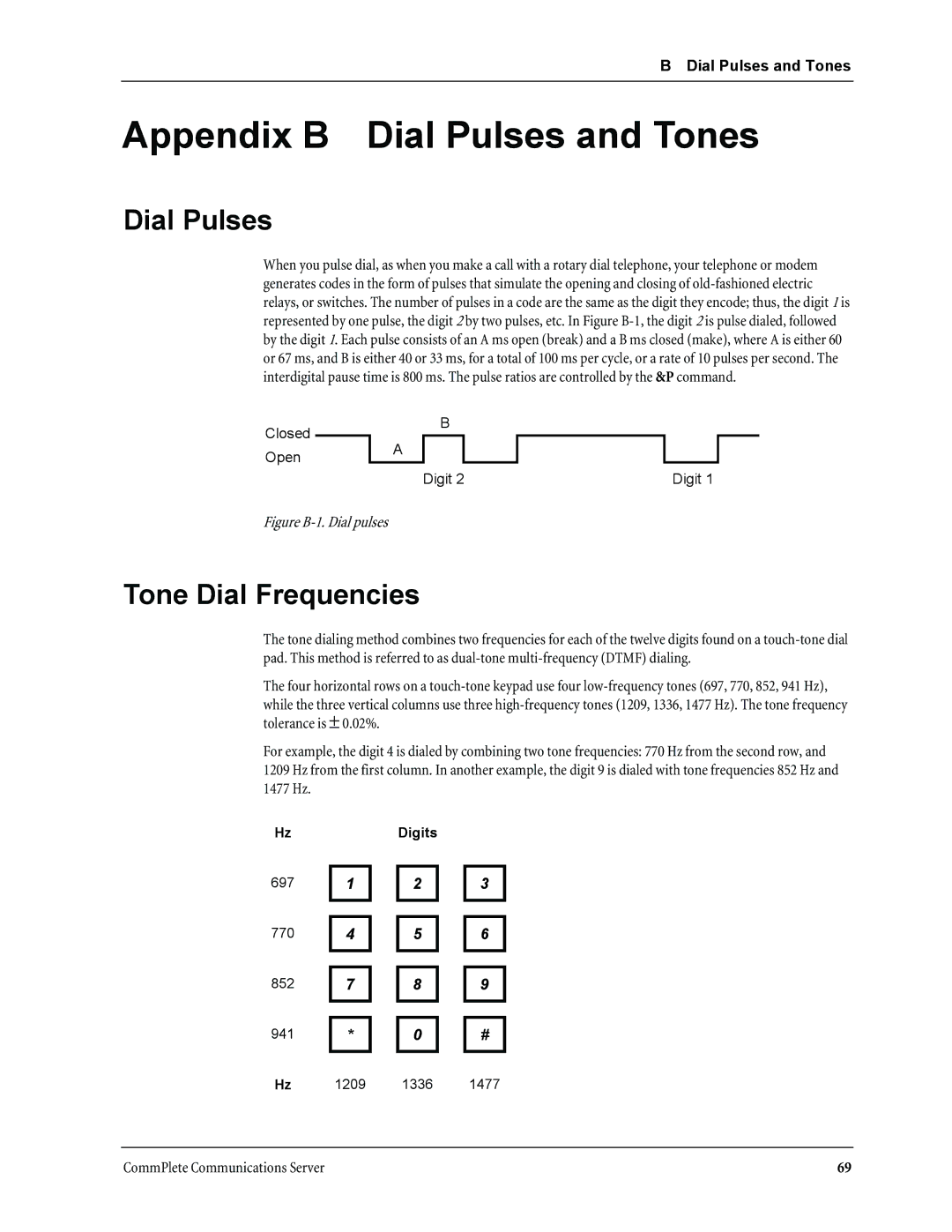MT3334HD8 Modem User Guide
Multi-Tech Systems, Inc Woodale Drive Mounds View, Minnesota
CommPlete Communications Server
Canadian Limitations Notice
FCC Fax Warning
Table of Contents
Appendix F
Testing the MT3334HD8
Warranty, Service, and Technical Support
Appendix D
Introduction
Manual Organization
LED Indicators
Power Supplies
Introduction
Installation
Data Rates Modem
Technical Specifications
Introduction 2400 & 1200 bps
MT3334HD8 User Guide Power
Installation
MT3334HD8 modem card
Safety Warnings
Installation Procedure
Pre-Installation Notes
Page
AT Commands
Working with AT Commands
Command Structure
Modes of Operation
Command Editing
AT Commands by Function
$BA
Continuous Redial
Dialing Commands
Dial Modifier Commands
Ds Dial
Wait for New Dial Tone
Pulse or Tone Dialing
Flash On-Hook
Rn Reverse Originate/Answer Mode
Return to Command Mode After Dialing
Dialing Pause
DsNd Store a Phone Number
Phone Number Memory Commands
@ Quiet Answer
Call Card Tone Detect
List Stored Telephone Numbers
Configuration Storage and Recall Commands
Wn Store Configuration
NdNe Number Linking
Modem Response Result Code Commands
Fn Load Default Configuration
Reset Modem
Echo Command Mode Characters
Result Codes Verbose/Terse
Bn Answer Tone
Online Connection Commands
An Answerback
#An Auto Speed Detection
DCn AT Command Control
CDn Cleardown at Disconnect
DTn Dtmf Detection
Pn Set Pulse-Dial Ratios
#Fn Fallback Modes
Gn Guard Tones
Hn Busy-Out After Disconnect
RDn Square Wave Ring Detect
$Tn Calling Tone
#Tn Trellis-Coded Modulation
RAn Asymmetric Bit Rate
Commands
Fn Echo Canceler Frequency Offset Compensation
Yn Long Space Disconnect
RS-232 Interface Commands
Cn Carrier Detect Control
Dn Data Terminal Ready Control
SFn DSR/CD Interaction Control
Rn Clear to Send Control
Sn Data Set Ready Control
RFn CTS/RTS Interaction Control
En Data Compression
Error Correction and Data Compression Commands
En Error Correction Modes
#Ln V.42 Error Correction Modes
$En V.42 Error Correction at 300 bps
$Fn Auto-Reliable Fallback Character Enable/Disable
$An Auto-Reliable Buffering
Speed Conversion Commands
$BAn Baud Adjust
$Rn Retransmit Count
$SBn Serial Port Baud Rate
$MBn Modem Baud Rate
L5, L7 List Current Operating Parameters
Immediate Action Commands
Repeat Last Command
Inquire Product Code
Flow Control Commands
E5 XON/XOFF Flow Control
E3 Flow Control Disable
En Non-Error Correction Mode Flow Control
E4 Hardware Flow Control
#Xn Number of Xoff Characters Sent
En Pacing Computer-Initiated Flow Control
Breakatcr Out-of-Band Escape Sequence
Force Answer Mode
Escape Sequences
+++ATCR In-Band Escape Sequence
Go Back Online
Remote Configuration Commands
Atcr Remote Configuration Escape Sequence
#Ixxxxxx Change Login Password
DFn Format Line Probe Data
Line Probe Commands
#Syyyyyy Change Setup Password
DPn Read Line Probe Data
Ln Display Line Probe Data
Diagnostic Commands
Tn Respond to Remote Digital Loopback Signal
RP Immediate Line Probe
Un Loopback Test Modes
MT3334HD8 User Guide
Registers
S2 Escape Code Character
Registers
S0 Number of Rings Until Modem Answers
S1 Ring Count
S6 Wait Time for Dial Tone
S7 Time for Carrier Abort Timer
S4 Line Feed Character
S5 Backspace Character
S11 Tone Dialing Spacing and Duration
S10 Carrier Loss Disconnect Delay Time
S13 Remote Configuration Escape Character
S9 Carrier Detect Response Time
S25 DTR Dropout Time
S30 Inactivity Timer
S34 Command Buffer Length After Online Escape Sequence
S24 PBX/CBX Disconnect Drop Time for DSR/CTS/CD
S48 Maximum V.34 Connect Speed
S94 Out-of-Service Time
S37 DTR Busy-In Time
S43 Force V.34 Connect Speed
Examples of Reading Values
AT Commands that Affect S-Registers
Reading and Assigning S-Register Values
Examples of Assigning Values
AT&E2$SP1#L3$R0$MB19200$SB115200$EB1S0=10&W0CR
Testing the MT3334HD8
Local Analog Loopback Test V.54 Loop
Test procedure
Remote Digital Loopback Test V.54 Loop
Testing the MT3334HD8
Dial the remote modem and establish your online connection
Local digital loopback test
Local Digital Loopback Test V.54 Loop
Page
Warranty, Service, and Technical Support
Service
Limited Warranty
Recording Product Information
Technical Support
Multi-Tech BBS
Logging onto the Multi-Tech BBS
Downloading a File
Bulletins
About CompuServe
Reading a Message
Leaving a Message
About the Internet
About the Multi-Tech Fax-Back Service
Upgrading the MT3334HD8 Firmware
Using FlashPro to Upgrade Firmware
MT3334HD8 User Guide
Appendixes
Ctrl Code HEX DEC
Appendix a Ascii Conversion Chart
Appendix B Dial Pulses and Tones
Dial Pulses
Tone Dial Frequencies
Figure B-2. Standard Dtmf frequencies
Multi-Tech Result Codes &Q0
Appendix C Result Code Summary
Standard AT Result Codes &Q1
Appendix D S-Register Summary
Register Unit Range Default Description
Sets fixed V.34 connect speed = 28800 bps
Return
Appendix E AT Command Summary
CDn
AT Command Summary
$Fn
Command Values Description
Command Values Description $MBn
RAn
Command Values Description SFn
Command Values Description #Vn
Breakatcr
Appendix F Remote Configuration
Basic Procedure
Setup
Changing the Remote Escape Character
Changing the Passwords
Index
MT3334HD8 User Guide
Index
Long space break
Pacing, 36, 37, 38 enable/disable, 38 ENQ/ACK
Commands Loopback tests, 42, 43, 54, 56 tone detection

